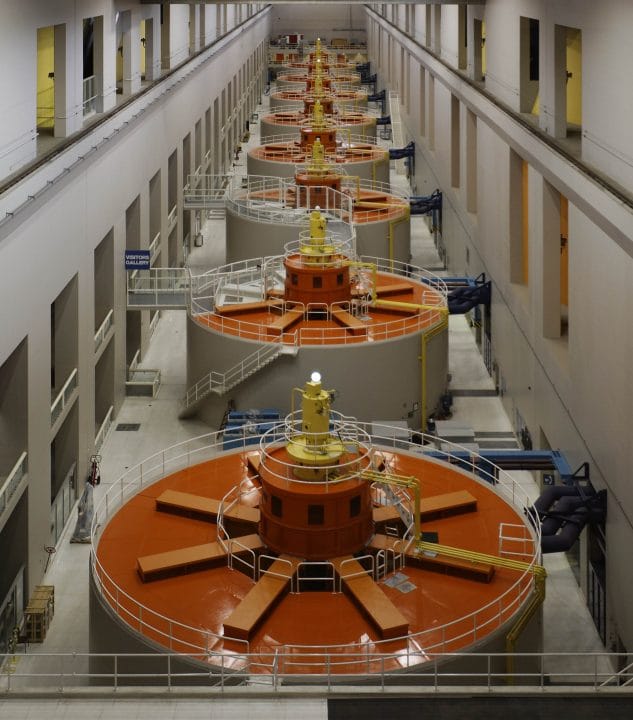Hydropower is a term we use to refer to electricity produced by harnessing the kinetic energy of moving water. Hydroelectric dams are a common method of generating hydroelectric power and are highly reliable when built in the right environment.
The below sections provide further information on what hydropower actually is and how we can generate it.
How Hydropower Is Generated
Moving or flowing bodies of water contain kinetic energy that we can harness to generate electricity. There are a number of ways we can generate hydropower. The most common is through the use of a hydroelectric dam which we will explain below.
With Hydroelectric Dams
A hydroelectric dam works by trapping a large body of water. This creates a man-made reservoir which the dam can tap into in order to drive turbines built into its structure. Large hydroelectric power plants often make use of a number of turbines to provide more power output. In the image below, you can see that this dam contains eight turbines in total.

Hydro plant operators control the flow of water from the reservoir. These water flows will follow a set path through the structure of the dam. They will eventually come into contact with the turbines. When they do, the turbines revolve and begin to generate electricity. The size and capacity of the turbines dictate the amount of electricity they can produce.
Through Other Means
We don’t always have to build giant hydroelectric dams to generate hydropower. Some companies have even realized the potential of the kinetic energy of the flowing water of our rivers. Such companies have been able to build small scale hydroelectric installations – a technology we often refer to as ‘micro hydro’. This method allows power companies or even local businesses (and some homeowners) to generate smaller volumes of hydroelectricity.
Micro hydro systems have a much smaller impact on the surrounding environment. We can use them for harnessing the power of flowing water without the need to dam a river. We can achieve this by using devices similar to water wheels – the type we traditionally use to power mills and factories. Such water wheels are able to turn with the natural flow of a river alone. This can generate low volumes of electricity that can be enough to power a small building.
Is Hydroelectricity Expensive?
Hydroelectricity is only expensive as a result of the initial cost of building a hydroelectric dam. This process involves lots of engineering and can take many years of planning and construction before a dam is complete.
After the construction of the dam, the only ongoing costs are for its operation and maintenance. Unlike non-renewable power stations, a hydroelectric dam doesn’t have to purchase any fuel to turn the turbines to generate electricity.
Hydropower’s Reliability
We can consider hydropower as a very reliable and efficient renewable energy source. You can achieve a constant electricity supply with the construction of a hydroelectric dam – unlike some other renewable energy technologies. For example, solar panels are vulnerable to darkness and wind turbines are vulnerable to wind levels. On the other hand, hydroelectricity can be almost constant when produced under the right conditions.
In addition to constant electricity production, hydropower has the added benefit of been able to react quickly to changing electricity demands. The water intake can be increased to spin turbines faster or bring additional turbines online, almost in real-time. This is helpful during periods of peak electricity usage. Traditional power stations (such as those fired by coal and oil) take significantly longer to adjust to spikes in electricity demands.
Reference our article on the pros and cons of hydroelectricity to weigh up the full range of advantages and disadvantages.
Overview
Hydropower is key to providing a long-term and reliable supply of electricity in many areas of the world. We have the potential to generate significant quantities of electricity both cheaply and with little to no pollution. This is great news for the atmosphere and the air we breathe.
You might be interested in the following external resources to learn more about what hydropower is.
- Hydropower on Wikipedia – An in-depth look into what hydropower actually is and its history.
- International Hydropower Association – Some informative articles, maps, and statistics to help you learn more about hydropower.